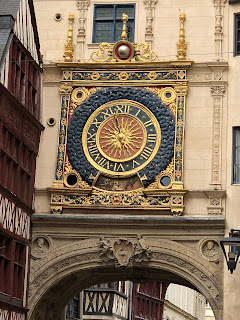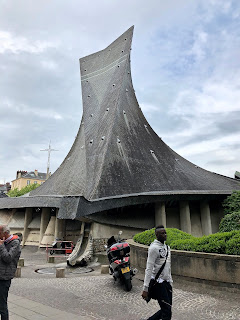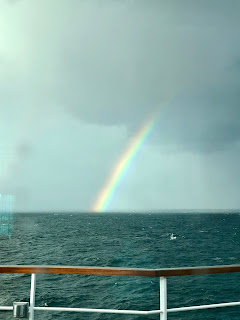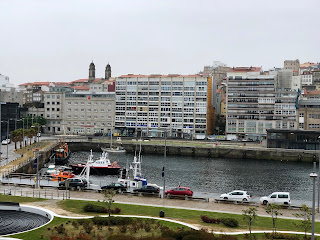I would have to say that today was one of the most moving
days I can remember experiencing.
We docked early in Cherbourg on the western coast of Normandy. Today we had booked an all-day tour of the
D-Day landing sites and beaches.
We set out at 8:30 with our guide Valerie through the really beautiful
Norman countryside. Along the way
there were lots of happy cows (I love cows!) and apple orchards. The exit signs had names like Saint-Lô
and Sainte-Mère-Église which are familiar from the history of the battle for
Normandy.
Our first stop was Arromanches, the site of one of two
Mulberry Harbors the Allies constructed after the D-Day landings. Because there was a need for harbors to
bring in supplies and equipment for the troops invading and because all the
ports were in German hands, the Allies designed artificial harbors to be used
until real ones could be captured.
The construction of these began on June 9, just three days after the
D-Day landings. They consisted of caissons and causeways sunk and placed in an
arc. There was a major storm on
June 19, 1944, which irreparably damaged the harbor built near Omaha Beach, but
the one at Arromanches was more protected and, while damaged, was still
useable. A few of the caissons can
still be seen. Arromanches has a
small but very informative museum about the harbor and the D-Day landings.
 |
| Closer view of one of the artificial breakwaters |
The most interesting thing about our visit to Arromanches
though was something else. In the
parking lot in front of the museum there was a group of uniformed French
military. It turns out we were
there at the swearing in of a group of French marines who had just completed
their training. The group marched
and sang as they marched and then marshaled in the parking lot, were sworn in,
given their hats, and sang the Marseillaise. I think I got a short video with my iPhone and I’ll try
posting it.
After leaving Arromanches we had lunch and then made our way
to the American Cemetery at Omaha Beach.
The cemetery is situated in
Colleville-sur-Mer atop the cliffs overlooking Omaha Beach. The land, some 200 acres, was donated
by the French government but is maintained by a commission of the US
government. 9387 US service
members are buried in the cemetery. An interesting tidbit of information is that 9386 were WWII
soldiers. Quentin Roosevelt, a son of President Theodore Roosevelt, who died in
WWI and was buried elsewhere in France
was exhumed and buried next to his brother Theodore Roosevelt Jr. That
only represents about 40% of the soldiers killed during the battle for
Normandy. Those killed were buried
in a number of different sites in Normandy. When this cemetery was established, the families of the
fallen were given the option of repatriating the remains of their family
members or having them moved to this cemetery.
At the east side of the cemetery is a semicircular colonnade with a loggia at either end and a garden with a wall on which are inscribed the names of 1557 Americans who were killed in the Normandy campaign but whose remains couldn't be located or identified. In the middle of the semicircle is a 22 foot bronze statue entitled The Spirit of American Youth Rising from the Waves. It's a fitting tribute to those who gave their lives.
 |
| Bronze statue |
 |
| View to the west across the reflecting pool to the chapel in the distance |
The place is beautifully maintained. The lines of white marble crosses, some
with a Star of David instead, stretch into the distance around a
non-denominational chapel. The
fallen are buried in no order except for 35 sets of family members who are
buried together. Besides the two Roosevelt
brothers perhaps the most famous are the Niland brothers who are the basis for
the movie Saving Private Ryan.
Each cross is engraved with the name, military unit, home state and date
of death of the individual. As we walked through the cemetery we came across
two graves of Virginians who were members of the 29th Division. That division was in the first waves
that landed on Omaha Beach and included a number of young men from the small
town of Bedford, Virginia.
Proportionally that little town suffered more casualties than any other
and the fallen came to be known as the Bedford Boys. We wondered if these crosses belonged to some of those brave
young men.
 |
| Field of crosses |
 |
| Inscription on the Chapel wall |
 |
| If you look you can see about five crosses back a small American flag at the foot of a cross. A relative must have been here to place it recently. |
I’m the daughter of someone who served in the Army as a
soldier and a civilian employee for more than 50 years and I can say honestly
that I thought as I walked through this place that anyone who thinks about war
should first have to pass through a cemetery like this. It was extremely moving to us.
From the cemetery we next drove down to Omaha Beach below
the cemetery. This was one of five
beaches on which landings were made and the deadliest that day. Our guide told us that the tides along
this coast can vary by 40 feet.
The invasion was timed to occur at mid-tide. Had it been at high tide the landing craft could have been
blown up on the beach obstacles
which had mines attached atop. Had
it been at low tide the troops would have had to traverse 100’s of yards more
with no cover at all. As it was,
they had to jump into water which for some was chest high and wade ashore
amidst a blistering and unrelenting barrage of fire. As I looked and thought about it I couldn’t imagine the
terror the soldiers must have felt as they ran down the ramps from their landing
craft. Just as horrible to conceive
was what the second and third waves must have thought as they came ashore with
the bodies of the earlier troops lying on that terrible beach. Each of those young men was a hero.
 |
| Omaha Beach from the heights above. Imagine these high places filled with German pillboxes and bunkers all with guns trained on the beach below |
 |
| Les Braves Memorial on the beach was commissioned by the French government to commemorate the 60th anniversary of the landing |
From Omaha Beach we traveled back to Cherbourg and our
ship. Cherbourg itself was a major
port and before it fell to the Allied forces the Germans virtually destroyed it
so that their foes couldn’t use it immediately.
This part of France has so much history to explore that I
think it’s someplace we should visit again. It’s from here that William the Conqueror launched his
invasion of England. If
Ancestry.com is to be believed Al’s ancestors 900 years ago came from
here. There’s a lot to see that we
haven’t yet, so we’ll have to come back.
Now our cruise is at an end. Tomorrow we’ll arrive in Dover, England. We have a car and driver picking us up
and taking us to Heathrow. Home
and Emma await us. This cruise has
been wonderful in all ways. So,
bye for now. Next time we’ll be
heading to Dubai for another trip through the Suez Canal.





































